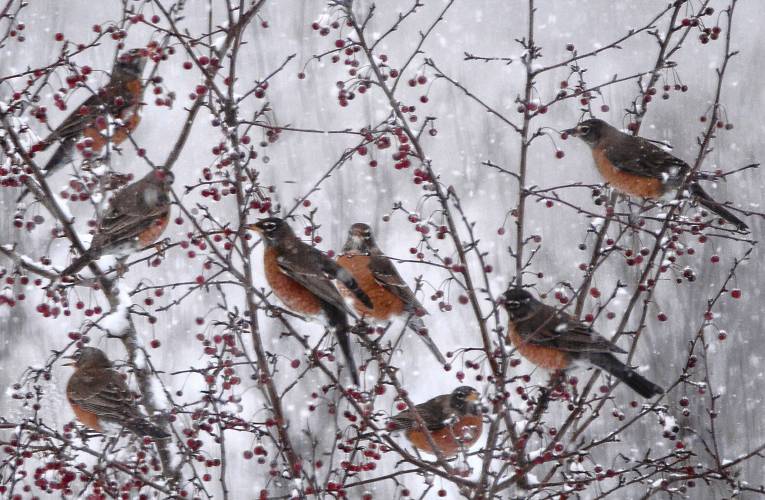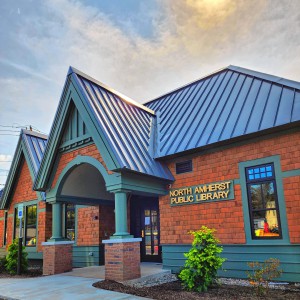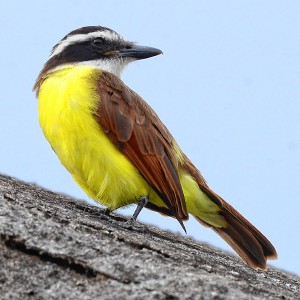Speaking of Nature: It happens every year: Robins brave the snow in search of food

Eight hungry American Robins have landed in a crab apple tree in the hopes of finding some food. These birds were members of a flock of over 100 birds that visited my yard. PHOTO BY BILL DANIELSON
| Published: 01-16-2024 11:45 AM |
Every winter I get a few emails from readers who want to know if it is normal to see American Robins in winter and every winter I send out responses that indicate that the presence of these birds is quite normal. I then go on to discuss various details about the entire topic, ensuring the concerned readers that this is not in any way unusual. However, recent events have once again brought this topic to the top of the pile of my writing topics.
As an avid birder, I spend what some people might consider an inordinate amount of time sitting and watching the feathered friends that visit my wintertime feeders. My personally imposed minimum observation window is one hour, but sessions of 2 to 3 hours are not unusual. I take careful notes and keep track of how many individuals of each species that I observe. Then I report my observations on a digital platform known as eBird.
The eBird platform is based out of the Cornell Laboratory of Ornithology, but it has a worldwide reach and bird enthusiasts around the world report their information about bird sightings. This has made eBird one of the largest biodiversity projects currently running, but the amazing thing about this endeavor is the fact that the people who collect all of the data are people like you and me. Citizens of the world who have an interest in birds can make an active contribution to science.
I share this with you so that you might understand the sense of wonder that I have felt over the presence of American Robins in my own yard (and airspace) at the beginning of 2024. Counting up the various finches, sparrows, woodpeckers and chickadees that come to my feeders every morning is a relatively simple task, but I was amazed when a large flock of over 100 robins flew over my house on Jan. 1. It happened again the following weekend, but this time the robins actually landed!
This was the weekend of the first “major” snowstorm of the winter. I awoke on the morning of Sunday, Jan. 7 to discover that the world had indeed been covered with a fresh blanket of snow. It was a winter wonderland and I settled in for a long watch. This was a smart move on my part because well after my mandatory 60 minute minimum I saw a horde of hungry robins descend upon the crab apple tree in my neighbor’s yard.
When cold weather causes the ground to freeze, what do robins eat? The answer is quite simple. They fan out across the landscape in search of fruit. Crap apple trees with small fruit are a favorite target, but there are many other trees and vines that hang onto their fruit during the winter. I recently wrote a column about watching Cedar Waxwings eating the berries of some winterberry bushes and I have no doubt that American Robins would happily do the same.
So, it was a somewhat magical moment when I personally observed a behavior that I am usually forced to write about from an impersonal natural history position. The snow was falling heavily and a mob of birds descended on a food source right in front of my eyes. I took a few photos through my kitchen window and was surprised to discover that there were a few European Starlings mixed in with the robins, but the general quality of the photos just wasn’t very high. If I wanted something that could be published I was going to have to make a move.
So, despite the heavily falling snow, I took a gamble and stepped out onto my deck. My concern was that my appearance would scare off the birds, but it quickly became apparent that their interest in finding something to eat was greater that any discomfort that they felt when I went outside. To be honest, there was no indication that they even noticed me, which was perfect for photography.
Article continues after...
Yesterday's Most Read Articles
 ‘Home away from home’: North Amherst Library officially dedicated, as anonymous donor of $1.7M revealed
‘Home away from home’: North Amherst Library officially dedicated, as anonymous donor of $1.7M revealed
 ‘We can just be who we are’: Thousands show support for LGBTQ community at Hampshire Pride
‘We can just be who we are’: Thousands show support for LGBTQ community at Hampshire Pride
 South Hadley man killed in I-91 crash
South Hadley man killed in I-91 crash
 Retired superintendent to lead Hampshire Regional Schools on interim basis while search for permanent boss continues
Retired superintendent to lead Hampshire Regional Schools on interim basis while search for permanent boss continues
 A Waterfront revival: Two years after buying closed tavern, Holyoke couple set to open new event venue
A Waterfront revival: Two years after buying closed tavern, Holyoke couple set to open new event venue
 Proposed Hatfield pickleball/tennis building raising eyebrows
Proposed Hatfield pickleball/tennis building raising eyebrows
The photo that I chose to share captured everything that was interesting on that morning. There are eight robins in the frame and only one of the birds in the center has a face that is minimally blurry.
The rest are giving their full attention to the food while the snow falls around them. I find that this photo has a wonderful watercolor appeal to it. The birds are recognizable, but the details are a little blurry because of the snow. The same is true with the background. You get the impression of a forest of trees without really seeing too much detail.
Anyway, the robins remained in the area for 10 to 15 minutes before they started to leave. When they were finally gone there were a surprising number of small apples still hanging from the branches of the tree. Perhaps those that had been left behind weren’t quite ready to eat yet. Needless to say, I will be keeping a sharp lookout on that particular tree to see if I can watch the progress of the disappearance of the apples. I know that the local deer are very fond of the fruits and they usually strip the lower branches of their delicacies by midwinter. So much to watch and wonder about!
Bill Danielson has been a professional writer and nature photographer for 26 years. He has worked for the National Park Service, the US Forest Service, the Nature Conservancy and the Massachusetts State Parks and he currently teaches high school biology and physics. For more in formation visit his website at www.speakingofnature.com, or go to Speaking of Nature on Facebook.

 Speaking of Nature: Capturing my Bermuda nemesis: The Great Kiskadee nearly evaded me, until I followed its song
Speaking of Nature: Capturing my Bermuda nemesis: The Great Kiskadee nearly evaded me, until I followed its song Easthampton author Emily Nagoski has done the research: It’s OK to love your body
Easthampton author Emily Nagoski has done the research: It’s OK to love your body Earth Matters: Honoring a local hero: After 40 years, Hitchcock Center bids farewell to educator and creative leader, Colleen Kelley
Earth Matters: Honoring a local hero: After 40 years, Hitchcock Center bids farewell to educator and creative leader, Colleen Kelley Valley Bounty: Delivering local food onto students’ plates: Marty’s Local connects farms to businesses
Valley Bounty: Delivering local food onto students’ plates: Marty’s Local connects farms to businesses
